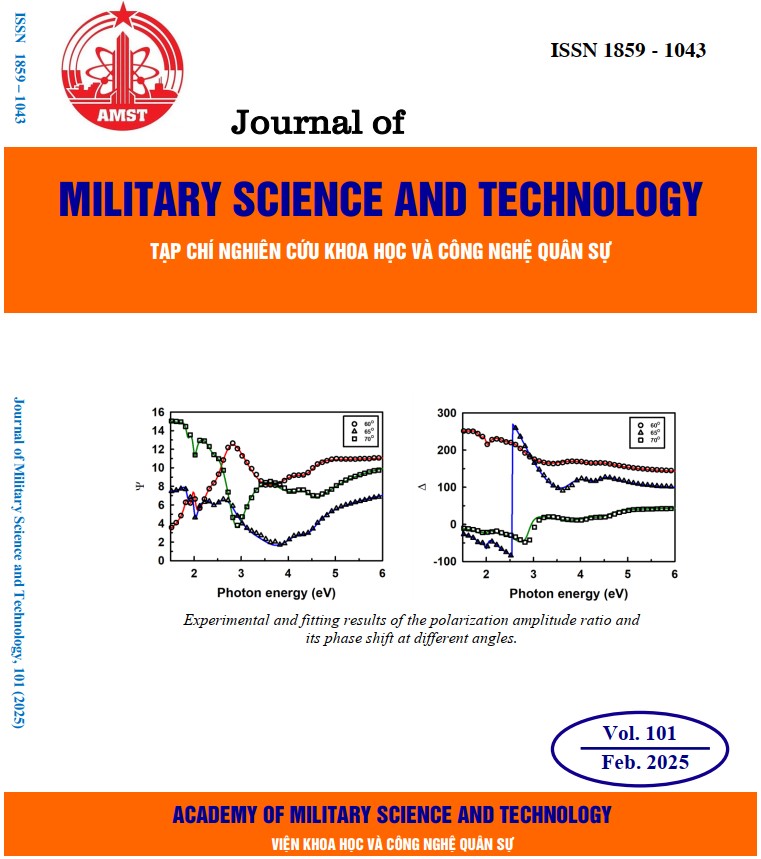A method of calculating spectral characteristics applied to optimize the thermal imaging system design
341 viewsDOI:
https://doi.org/10.54939/1859-1043.j.mst.101.2025.124-130Keywords:
Thermal imaging system; Optical design; Spectral characteristics.Abstract
In the design of thermal imaging systems, the selection of wavelengths and their relative weights plays a critical role in design optimization, directly influencing the system’s final performance. The spectral characteristics of a thermal imaging system, which encompass the distribution of wavelengths within the primary optical beam, must be thoroughly analyzed prior to initiating the optical design process. These characteristics are shaped by key factors, including the target’s emission spectrum, the medium’s and optical component’s transmission properties, and the detector sensitivity. This paper presents a detailed investigation and quantitative analysis of the spectral characteristics of a thermal imaging system under real-world environmental conditions, emphasizing their implications for system design. The findings provide valuable insights into how these spectral parameters influence design outcomes, contributing to enhanced research, optimized system development, and improved performance in practical applications.
References
[1]. W. L. Wolf. “Handbook of military infrared technology”, Office of Naval Research Department of the Navy, Washington, (1965).
[2]. W. L. Wolfe. “Infrared design examples”, SPIE Press, Washington, pp. 180, (1999). DOI: https://doi.org/10.1117/3.343801
[3]. L. N. Cường, “Nghiên cứu thiết kế chế tạo thiết bị ảnh nhiệt quan sát tầm trung TBAN-IR120”, Tạp chí Nghiên cứu KH&CN Quân sự, Số Đặc san Vật lý kỹ thuật, (2013) (in Vietnamese).
[4]. P. Đ. Quý, “Phương pháp tính toán cự ly hoạt động của thiết bị ảnh nhiệt dựa trên độ chênh lệch nhiệt tối thiểu”, Tạp chí Nghiên cứu KH&CN Quân sự, Số 70, (2020) (in Vietnamese).
[5]. N. A. Tuấn, “Tính toán thiết kế và chế tạo hệ quang trộn ảnh kết hợp khuếch đại ánh sáng yếu và ảnh nhiệt”, Tạp chí Nghiên cứu KH&CN Quân sự, Đặc san Hội thảo FEE, (2020) (in Vietnamese).
[6]. A. T. Hoang, “Design the compact dual FOV infrared optical system for the application in a mixed day and night observation equipment”, Journal of Military Science and Technology, 89(8, 117-123), (2023).
[7]. N. Q. Hiệp, “Nghiên cứu thiết kế hệ thống quang học của ống kính ảnh nhiệt có tiêu cự thay đổi nhảy bậc”, Tạp chí Khoa học và Kỹ thuật, 18(2), (2023) (in Vietnamese). DOI: https://doi.org/10.56651/lqdtu.jst.v18.n02.686
[8]. M. Planck, “The Theory of Heat Radiation”. (2nd ed.). P. Blakiston's Son & Co. OL 7154661M, (1914).
[9]. ISO catalogue, “Thermal insulation - Heat transfer by radiation - Physical quantities and definitions”, ISO 9288:1989, (1989).
[10]. J. H. Taylor, “Atmospheric Transmission in the Infrared,” J. Opt. Soc. Am. 47, 223-226 (1957). DOI: https://doi.org/10.1364/JOSA.47.000223
[11]. Modtran Program. http://modtran.spectral.com/.
[12]. D. F. Swinehart, “The Beer-Lambert Law”, Journal of Chemical Education, 39(7), (1962). DOI: https://doi.org/10.1021/ed039p333
[13]. Production Catalog Tau2 Quark2, FLIR.







